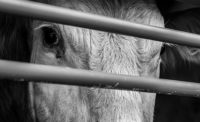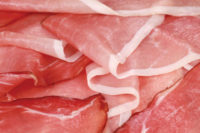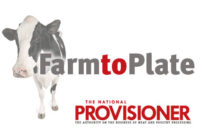When it comes to humane livestock handling, the quality of an animal’s handling experience is largely dictated by the skill and patience of the handler. However, quality facilities don’t hurt.
There are some simple facility characteristics that can make or break a handling facility over time.
It takes attention to detail and quality work to make sure your facility will last for the long haul.
Dr. Temple Grandin, president of Grandin Livestock Systems, shared her insight on designing a long-lasting meat plant livestock handling and lairage facility.
Concrete
The quality of the concrete work in a livestock handling facility typically receives little attention unless it has been improperly installed or is degrading prematurely.
Worn-out concrete floors can create slipping and falling hazards for animals and handlers, especially when the surface is wet. There are short-term fixes that can be applied to worn concrete surfaces, such as the addition of welded rebar grid to add profile for hooves to grip, but nothing truly replaces the original profile of a concrete floor once it has worn smooth.
Grandin recommends stamping concrete for cattle alleys and holding pens with 8 inch by 8 inch diamond patterns. The grooves should be approximately one inch deep. For pigs and sheep, expanded metal mesh can be used to stamp texture into wet concrete.
To ensure a long service life for new concrete installations in livestock handling facilities, ready-mix batches must be formulated to provide appropriate compressive strength. Grandin cautions, “This is a place where some people cut corners, and the floor quickly wears out. I have seen poor concrete work wear down to the steel reinforcing rods in six months.”
She recommends concrete with a minimum compressive strength of 3,000 psi. Poured slabs should be at least six inches thick.
Unfortunately, there is no easy way to determine the compressive strength of concrete until after it has cured. If there is doubt regarding the actual hardness of concrete that has been installed, core samples can be cut and sent to a lab for testing.
Walls
One of the most important aspects of wall construction in livestock handling facilities is moisture resistance. It is inevitable that livestock handling facilities will be exposed to moisture during handling or during sanitation. It is important to remember that some materials are better for high humidity and moisture settings, and that these materials will typically cost more.
“Never use fiberglass insulation with a soft plastic vapor barrier,” Grandin says. “Birds and rats will tear holes in it.”
Insulated cooler panels are Grandin’s choice for adding insulation to roofs and walls.
Gates and fences
Steel is the typical material for gate and fence construction. Its strength, ability to bend without breaking, and moisture and abrasion resistance make it a lower-maintenance building material.
However, not all steel tubing is the same. Steel tubing with thin walls will be more likely to bend, break and prematurely wear. An easy way to determine if pipe wall thickness is acceptable is to find the weight of the pipe per linear foot. Here are Grandin’s specifications for steel pipe used for post construction:
- Gate Posts: 6 inch outside diameter, 17 lbs. per linear foot minimum
- Fence Posts: 2 7/8 inch outside diameter, 6.5 lbs per linear foot for used pipe. 7.5 lbs per linear foot for new pipe. All values are minimum.
In addition to the structural integrity of the steel and the quality of installation, don’t overlook the addition of a surface finish to new steel structures. Aside from adding to the aesthetic quality of a new handling facility, paint helps to protect steel from corrosion.
This point is emphasized by Grandin: “Paint or galvanize all steel structures in the yard. I am seeing too many new facilities that are not painted. They will rust out more quickly.”
Ventilation
Air movement is very important in livestock facilities. In addition, large roof vents are needed to prevent buildup of condensation on the ceiling of the facility. Condensation in this location is more than just a dripping nuisance. Over time, moisture can cause the rafters, stringers and roofing fasteners to deteriorate.
Lighting
Food animals are greatly affected by the quality of lighting in their environment. In handling facilities, diffuse light that does not create many shadows and allows for good vision is needed. This isn’t as simple as installing lights and changing bulbs when they burn out. Some lighting needs to be replaced as it ages because it will begin to dim.
“Sodium lighting is really bright when it is new, but it slowly gets dim over several years,” Grandin notes. “This may cause a gradual increase in cattle or pigs balking because they do not like to go into dark places.”
Facilitating sanitation
Any livestock handling facility that has been planned for long-term use will be easy to clean. Water- and chemical-resistant wall panels and flooring are a must. Unsealed plywood and OSB will not last in these conditions.
To facilitate the wash-down process, Grandin recommends adding concrete curbs between livestock pens to direct wash water and prevent it from flowing into occupied pens. Floors should be sloped to facilitate flow toward drains, but the maximum slope should not exceed 2 percent. Excessive slope in pens can cause animals to crowd toward the lowest point in the pen.
In the end, the key to designing a good livestock handling and lairage facility is attention to quality. Be sure that you work with experienced contractors you can trust and use materials that will last. Review and think through project designs until you are certain you will get the results you want.
If your livestock handling facilities are designed with functionality and longevity in mind, they can provide years of worry-free service.





Report Abusive Comment